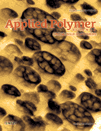Structural changes in the carbon black network in carbon-black-filled styrene-butadiene rubber samples cured with a two-step process
Abstract
The volume resistivity of carbon black (CB)-filled crosslinked styrene-butadiene rubber (SBR) samples cured in two steps and having a fixed elongation condition declined slightly when the elongation ratio (α) was 3 or smaller, whereas the value increased markedly at α = 4. Three-dimensional transmission electron microscopy observations revealed that the closest interparticle distance between the carbon black aggregates (CBag's) and the CBag number density decreased at α = 1−2 but increased at α = 4 and that the distance between the centers of gravity of the closest CBag and the volume of CBag increased at α = 1−3 but decreased at α = 4. Also, the fraction of crosslinked chains of the carbon black network (CBnet) was decreased with elongation, and the fraction of branched chains increased. The fraction of isolated chains in particular showed a more pronounced increase at α > 3 compared with α < 3. These results presumably imply that for the sample with α > 3, the coarsened CBag's were finely divided and also that the CBnet was broken by elongation. © 2012 Wiley Periodicals, Inc. J. Appl. Polym. Sci., 2013




